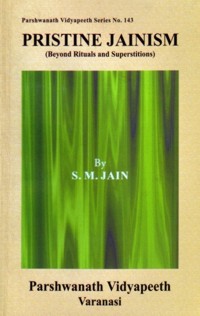Dr. L.M. Singhvi, M.P.:
Senior Advocate, Supreme Court of India Member, Permanent Court of Arbitration at The Hague President, Indira Gandhi National Centre for the Arts Trust,
Formerly India's High Commissioner in U.K., Chairman, High Level Committee on Indian Diaspora.
Shri S.M. Jain, is a retired Forest Officer and has worked on many responsible and challenging posts in State Forest Department. With his vast knowledge and experience of forestry, Shri S.MJain analyses certain issues relating to Jainism and the Jain way of life. His analysis leads him to research into what he calls Pristine Jainism.
According to Shri S.M. Jain, Pristine Jainism which emphasised rational activity and good conduct as preached and practised by liberated souls, the Arhats, is now overwhelmed by rituals and ostentatious display of wealth in the name of and on the pretext of Bhakti. He argues that the precepts of Jainism are simple and are based on scientific principles of cause and effect and on an understanding of the chain of action, reaction and interaction. He makes a plea for rationality in belief, thought and action and a plea for the rejection of rituals and superstitions. He underlines the contradiction between the Jain concept of Samyakatva rooted in an objective and rational perception of reality, that which is and Mithyatva which leads to an unreal and erroneous understanding and conduct. He shows that the Jain doctrine favours Purushartha and exhorts against inaction, which Jainism dubs as Pramad. He challenges various forms of ritual worship and interprets Jain teachings in the perspective of scientific rationality at the heart of which is the principle of symbiosis or interdependence of life at all levels and in all its manifestations.
Shri Jain is in his element in his chapter on Kalpavrikshas (Forests) in Jainism. Marking his point of departure from mythological and canonical literature which attributes "miraculous benevolence" and "superstitious superlatives" to Kalpavrikshas and tends to identify them with Adansonia digitata (the bread trees), Shri Jain takes us to the Jain tradition expounded by Yati Vrishbhacharya in Tiloyapannati who refers to ten illustrative types of Kalpavrikshas. To quote from Tiloypannati,
पाणंग-तरियंगा, भूसण-वत्थंग-भोयणांम य
आलय-दीविय-भायण-माला-तेजंग आदि कल्पतरू ||242||
[ Tiloypannati, 2nd Part 4th Chapter ]
Those ten types are Panang (yielding liquid products for drinking), Turyang (giving wood and other material for making musical instruments), Bhushnang (giving material flowers etc for ornamentation), Vastrang (giving fibrtes, dyes, chemicals, gums etc. for clothing etc.), Bhojnang (giving edible fruits, seeds, nuts, leaves, flowers etc for food), Alayang (giving timber etc for construction of houses), Dipang (giving material used for fire, lighting), Bhajanang (from which material for utensils is available), Malang (giving decorative flowers etc.) and Tejang (which protect from harmful radiations of sun). In another verse, Yati Vrishbhacharya mentions the bountiful flowering, fruiting and sprouting trees. Shri Jain then points out that in a generic sense Kalpavrikshas stands for forests and for sustainability. His conclusion is that "preservation of forests is inversely proportional to extension and development for agriculture, " and one may add, the preservation of trees and forests' is also inversely proportional to the extension of concrete jungles which threatens sustainable ecology" Kalpavriksha culture in the Jain tradition should thus be interpreted as sustainable and environment friendly model of forest culture and agriculture.
Shri Jain deals with cyclic changes and explains the Jain tradition, which questions the idea of an anthropomorphic Creator-God. The question was raised in Rig Veda also: "if the universe was created then what for? From where? Who saw it being created first?" The author explains that, according to Jainism, the universe is without a beginning and without an end. He also annotates the theory of cyclic changes as explained in canonical Jain literature notably in Tiloypannati by Yati Vrishabhacharya and in Adipurana. Describing the grim situation in the present era of Dukhma, he describes the agonising problems of human existence and the bewildering predicament of humanity in this period. The Jain tradition counsels limitation of population, limitation of wants and use of natural resources in accordance with constraints of availability and renewability.
Shri Jain's chapter on Code of Conduct has a profoundly contemporary relevance and is based on the centrality of the principles of Reciprocity and Interdependence of all life. He puts to the present generation the question which Gautam, the principal disciple of Lord Mahavira, put to the great master,
कहं चरे, कहं चिट्टे, कहं आसे, कहं सए,
कहं गुजंतो, भावं-पावं कमं न बंधई?
Every individual and the civil society itself should ask the question, which Gautam asked, and we must remember the answer the Lord Mahavira gave. Lord Mahavira's answer was: "When you dwell, walk, stay, eat, speak, sleep and live carefully, cautiously and with consideration, you will not be guilty of sin". That care, caution and consideration for one and all is indeed the Dharma of humanity. That is the sheet anchor of Non-violence.
According to the author, "Jainism subscribes to mutualism and opposes predation, parasitism, exploitation and violence in any form. It enjoins on its laity (house holders) and ascetics (monks) strict adherence to code of conduct, revering all forms of life, big and small and prescribing careful, judicious utilisation of gifts of nature with utmost respect for all animate and inanimate constituents of environment."
Shri Jain explains the concept of meditation in Jainism. He advocates emotional discipline above all and suggests the optimum practice of the five great vows He explains the Daslakshana
Dharma (Ten Aspects of Religion) which constitute the core of the philosophy, ethics and way of life which is the heritage of Sramana tradition as well as the Vedic tradition. The great Veda Vyasa, expounds the same ten facets of Dharma in Mahabharata. Those ten aspects of Dharma are:
(1) Forgiveness;
(2) Absence of arrogance and false pride;
(3) Avoidance of hypocrisy;
(4) Avoidance of greed;
(5) Cultivation of Truth;
(6) Practice of Restrain or Samyam;
(7) Practice of Tolerance;
(8) Practice of Detachment; Simplicity, Sincerity and avoidance of Egoism;
(9) Avoidance of Profligacy and Lust; and
(10) Cultivation of Celibacy.
Those are the hallmarks of the Jain tradition. It may indeed be described as universal Dharma.
Shri Jain also deals with other salient features of Jainism in this book, such as Non-Absolutism (Anekant). Cosmology, Mythology and Parapsychological studies about the soul.
Shri Jain writes forcefully and insightfully about Pristine Jainism. His critical ideas may appear to be radical but they are rooted in his constructive concept of Pristine Jainism. His book deserves thoughtful consideration from the point of view of philosophy and ethics as well as social and doctrinal reforms.
L.M. Singhvi
 S.M. Jain
S.M. Jain
